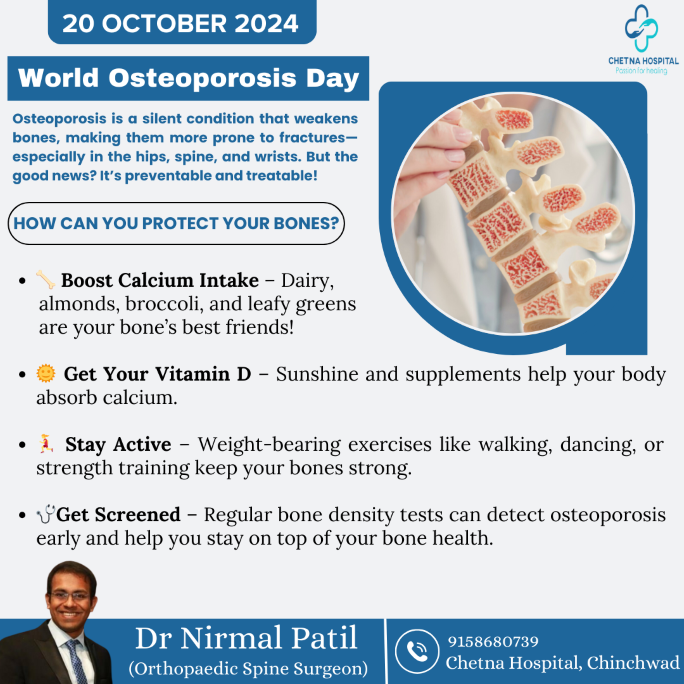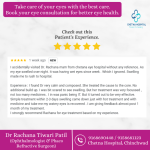Every year, October 20th marks World Osteoporosis Day, a day dedicated to raising awareness about osteoporosis, a condition that weakens bones, making them fragile and more likely to break. This global event aims to educate the public about prevention, diagnosis, and treatment options for this silent disease, which affects millions of people worldwide, particularly older adults and postmenopausal women.
What is Osteoporosis?
Osteoporosis is a skeletal disorder characterized by low bone mass and deterioration of bone tissue, leading to an increased risk of fractures. The condition often progresses without symptoms until a fracture occurs, which is why it is often referred to as a “silent disease.” According to the International Osteoporosis Foundation (IOF), approximately 1 in 3 women and 1 in 5 men aged 50 and older will experience a fracture related to osteoporosis in their lifetime.
How Osteoporosis Develops
Bone is a dynamic tissue that undergoes constant remodeling through a process involving the activity of two types of cells: osteoblasts, which build new bone, and osteoclasts, which break down old bone. In healthy individuals, this balance is maintained, but in those with osteoporosis, the rate of bone resorption outpaces the formation of new bone, leading to decreased bone density.
Several factors contribute to the development of osteoporosis, including:
- Age: Bone density naturally decreases with age, particularly after reaching peak bone mass in early adulthood.
- Hormonal Changes: Decreased levels of estrogen in women after menopause significantly contribute to bone loss. In men, low testosterone levels can also affect bone density.
- Genetics: A family history of osteoporosis increases an individual’s risk.
- Lifestyle Choices: Poor nutrition, lack of physical activity, smoking, and excessive alcohol consumption can all contribute to the development of osteoporosis.
Risk Factors
Identifying risk factors is crucial for prevention and early intervention. Some common risk factors include:
- Age: Risk increases as one ages.
- Gender: Women are at higher risk, especially after menopause.
- Body Frame Size: Individuals with smaller body frames tend to have a higher risk.
- Family History: A family history of osteoporosis or fractures can increase risk.
- Diet: Low calcium and vitamin D intake can contribute to bone loss.
- Sedentary Lifestyle: Lack of weight-bearing exercise can weaken bones.
- Medical Conditions: Certain diseases, such as rheumatoid arthritis and hormonal disorders, can increase the risk of osteoporosis.
- Medications: Long-term use of corticosteroids and some other medications can negatively impact bone density.
Prevention Strategies
Prevention is key in the fight against osteoporosis. Here are some effective strategies to help maintain bone health:
1. Nutrition
A well-balanced diet rich in calcium and vitamin D is essential for bone health. Foods that are excellent sources of calcium include:
- Dairy products (milk, yogurt, cheese)
- Leafy green vegetables (kale, broccoli)
- Fortified foods (orange juice, cereals)
- Fish (sardines, salmon with bones)
Vitamin D helps the body absorb calcium and can be obtained from:
- Sun exposure
- Fortified foods
- Supplements
2. Exercise
Regular physical activity, particularly weight-bearing and strength-training exercises, plays a vital role in building and maintaining bone density. Recommended activities include:
- Walking
- Jogging
- Dancing
- Weightlifting
- Climbing stairs
3. Healthy Lifestyle Choices
Avoiding smoking and limiting alcohol consumption are crucial for maintaining bone health. Smoking can weaken bones, while excessive alcohol intake can interfere with calcium absorption.
4. Regular Screening
For those at risk, regular bone density tests can help monitor bone health. The most common test is dual-energy X-ray absorptiometry (DEXA), which measures bone density in various parts of the body, such as the hip and spine.
5. Medication
For individuals diagnosed with osteoporosis, doctors may prescribe medications to help prevent further bone loss. These include:
- Bisphosphonates: These drugs help slow down bone loss and are commonly prescribed for osteoporosis.
- Hormone Replacement Therapy (HRT): HRT can help restore estrogen levels in women after menopause, reducing bone loss.
- Calcitonin: A hormone that helps regulate calcium levels in the body and can be used to treat osteoporosis.
- Denosumab: A medication that can help prevent bone loss by inhibiting osteoclast activity.
Awareness and Education
World Osteoporosis Day serves as a vital platform for raising awareness about osteoporosis. Various organizations, including the International Osteoporosis Foundation (IOF), conduct campaigns to educate the public about the importance of bone health and encourage individuals to take proactive steps to prevent osteoporosis.
Activities on World Osteoporosis Day
- Educational Workshops: Many hospitals and health organizations host workshops to educate the community about osteoporosis risk factors, prevention strategies, and treatment options.
- Screening Events: Free bone density screening events are often held to encourage individuals to get tested and learn about their bone health.
- Health Fairs: Community health fairs may include booths focused on osteoporosis, offering information, resources, and consultations with healthcare professionals.
- Social Media Campaigns: Organizations utilize social media platforms to spread awareness, share personal stories, and provide tips for maintaining bone health.
The Role of Healthcare Professionals
Healthcare professionals play a critical role in the fight against osteoporosis. They can help identify at-risk individuals, provide guidance on lifestyle changes, and recommend appropriate screening and treatment options. Regular check-ups and open discussions about bone health are essential for early detection and prevention.
Living with Osteoporosis
For those diagnosed with osteoporosis, it is crucial to maintain a positive outlook and follow a comprehensive treatment plan. While osteoporosis can increase the risk of fractures and other complications, individuals can lead active and fulfilling lives by:
- Staying Active: Engage in low-impact exercises, such as walking or swimming, to maintain mobility and strength.
- Safety Precautions: Make home modifications to reduce the risk of falls, such as removing tripping hazards and using non-slip mats.
- Support Networks: Join support groups to connect with others facing similar challenges, share experiences, and find encouragement.
Conclusion
World Osteoporosis Day serves as a reminder of the importance of bone health and the need for awareness, prevention, and treatment of osteoporosis. By educating ourselves and others, we can take proactive steps to combat this silent disease. Remember that healthy bones are essential for a healthy life. Let’s work together to raise awareness and promote better bone health for everyone!
By prioritizing our bone health today, we can help prevent the consequences of osteoporosis tomorrow. Join us in spreading awareness and encouraging proactive measures to combat osteoporosis this World Osteoporosis Day!
For Consultation Contact us on 9158680739
Website – www.chetnahospital.co.in
Address – Chetna Hospital, Sambhajinagar, MIDC, G Block, Near Rotary Club, Chinchwad 411019
.
.
.
#pune#pcmc#chinchwad#hospital#medical#medicalservices#spinesurgeon#backspecialist#sciatica#sciaticnerve#sciaticapain#sciaticatreatment#spinesurgery#spinespecialist#spinedoctor#backpaindoctor#endoscopicspinesurgery#orthopaedicsurgeon#mistlifsurgery#cervicalpain#spinalcord#rediculopathy#backpainrelief#slippeddisc#spine#neckpain#spinalstenosis#lumberlordosis#backbonesurgery













